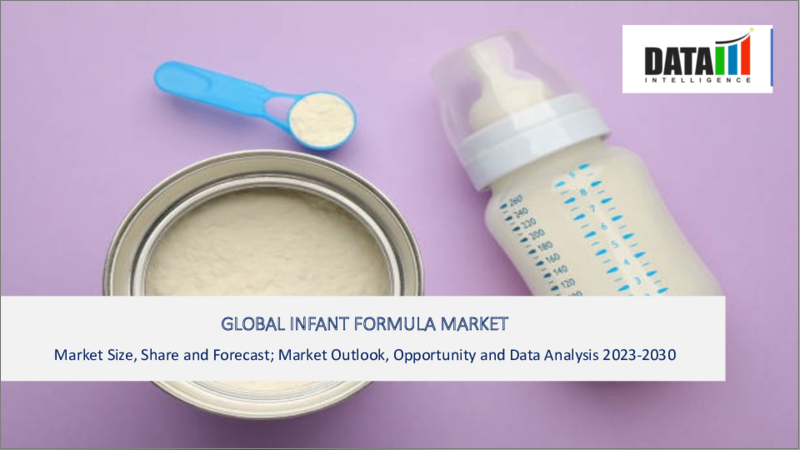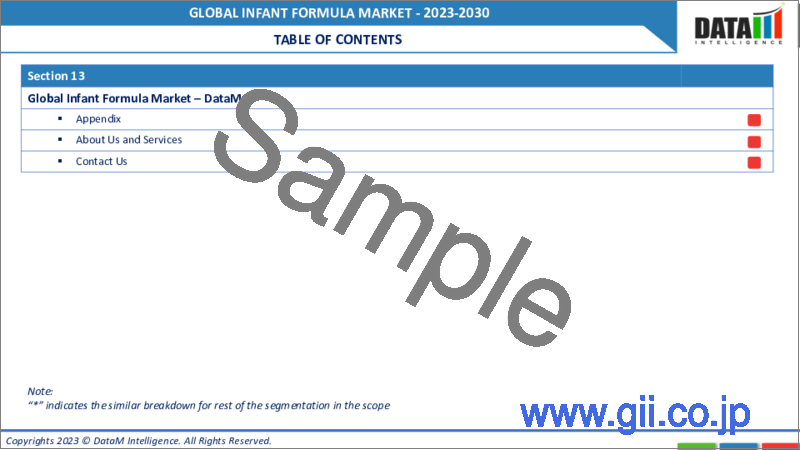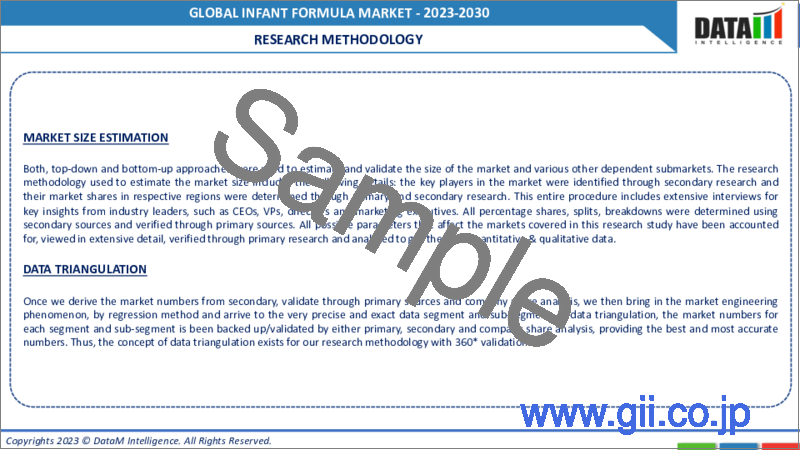|
|
市場調査レポート
商品コード
1304471
乳児用調製粉乳の世界市場-2023年~2030年Global Infant Formula Market - 2023-2030 |
||||||
カスタマイズ可能
適宜更新あり
|
|||||||
| 乳児用調製粉乳の世界市場-2023年~2030年 |
|
出版日: 2023年07月07日
発行: DataM Intelligence
ページ情報: 英文 195 Pages
納期: 即日から翌営業日
|
- 全表示
- 概要
- 目次
市場概要
乳児用調製粉乳の世界市場は、2022年に552億米ドルに達し、2030年には1,107億米ドルに達するなど、有利な成長が予測されています。予測期間2023-2030年のCAGRは9.1%と予測されます。
乳児用調製粉乳は、母乳のみで育てられていない乳児に必要な栄養素を供給するために設計された特殊な食品です。母乳の代用品として機能し、乳児の栄養において重要な役割を果たしています。乳児用調製粉乳は、成長期の乳児の栄養ニーズを満たすよう慎重に配合されており、タンパク質、炭水化物、脂質、ビタミン、ミネラルがバランスよく配合されています。乳児への栄養補給に便利で利用しやすい選択肢を提供し、乳児が健康な成長と発育のために十分な栄養を摂取できるようにします。
乳児用調製粉乳の世界市場は、人口の増加、可処分所得の増加、ライフスタイルの変化などの要因によって、近年着実な成長を遂げています。乳児用調製粉乳市場は、母乳育児に代わる便利で栄養バランスの取れた製品として需要が拡大しています。乳児用調製粉乳市場は、製剤や製品の技術革新の継続的な進歩により、今後も上昇基調を維持すると予想されます。
市場力学
需要の拡大と進歩が乳児用調製粉乳市場の進化を牽引
乳児用調製粉乳市場の動向は、いくつかの重要な要因によって牽引されています。まず、新興国を中心とした世界人口の増加により、乳児用調製粉乳製品の消費者層が拡大しています。さらに、ライフスタイルの変化と働く母親の増加が、便利で栄養バランスの取れた授乳オプションの需要を高めています。さらに、科学的研究開発の進歩により、栄養成分が強化された改良型乳児用粉乳製品が処方されるようになっています。
これらの製品には現在、DHA(ドコサヘキサエン酸)やARA(アラキドン酸)といった主な成分が配合されており、乳児の最適な成長と発育に不可欠な栄養素を提供しています。さらに、乳児の栄養と母乳育児の代用品の利点に関する意識の高まりが市場に影響を与え、親は高品質で安全な乳児用調製粉乳の選択肢を求めています。全体として、こうした要因が乳児用調製粉乳市場シェアのプラス成長に寄与しています。
厳しい規制と品質管理基準が乳児用調製粉乳市場に課題をもたらす
乳児用調製粉乳市場の主な抑制要因は、規制機関が課す厳しい規制と品質管理基準です。乳児用調製粉乳市場の分析によれば、こうした規制を確実に遵守し、高い製品品質を維持することは、メーカーにとって困難なことです。コンプライアンス違反や製品品質の問題があれば、法的な影響や風評被害、消費者の信頼喪失につながりかねないです。
このような厳しい規制を遵守するためには、研究開発、試験に多大な投資が必要となり、製造コストが増大する可能性があります。メーカーは、乳児用調製粉乳製品の安全性、有効性、コンプライアンスを確保するために、こうした規制上の課題を乗り越えなければならないです。乳児用調製粉乳の市場シェアは、メーカーがこうした規制要件を満たし、乳児の栄養ニーズを満たす高品質の製品を提供すると同時に、保護者に安心感を与えることができるかどうかによっても影響を受ける。
COVID-19影響分析
COVID-19分析には、COVID前シナリオ、COVIDシナリオ、COVID後シナリオに加え、価格力学(COVID前シナリオと比較したパンデミック中およびパンデミック後の価格変動を含む)、需給スペクトラム(取引制限、封鎖、およびその後の問題による需給の変化)、政府の取り組み(政府機関による市場、セクター、業界を活性化させる取り組み)、メーカーの戦略的取り組み(COVID問題を緩和するためにメーカーが行った取り組み)が含まれます。
目次
第1章 調査手法と調査範囲
第2章 定義と概要
第3章 エグゼクティブサマリー
第4章 市場力学
- 影響要因
- 促進要因
- 抑制要因
- 機会
- 影響分析
第5章 産業分析
- ポーターのファイブフォース分析
- サプライチェーン分析
- 価格分析
- 規制分析
第6章 COVID-19分析
第7章 タイプ別
- 乳児用ミルク
- フォローオンミルク
- その他
第8章 流通チャネル別
- スーパーマーケット/ハイパーマーケット
- 薬局/医療ストア
- 専門店
- その他
第9章 地域別
- 北米
- 米国
- カナダ
- メキシコ
- 欧州
- ドイツ
- 英国
- フランス
- イタリア
- スペイン
- その他欧州
- 南米
- ブラジル
- アルゼンチン
- その他南米
- アジア太平洋
- 中国
- インド
- 日本
- オーストラリア
- その他アジア太平洋地域
- 中東・アフリカ
第10章 競合情勢
- 競合シナリオ
- 市況/シェア分析
- M&A分析
第11章 企業プロファイル
- Nestle S.A.
- 会社概要
- 製品ポートフォリオと説明
- 財務概要
- 主な発展
- Danone S.A.
- Abbott Laboratories
- Mead Johnson Nutrition Company
- Reckitt Benckiser Group plc
- FrieslandCampina
- The Kraft Heinz Company
- Beingmate Baby & Child Food Co., Ltd.
- Royal FrieslandCampina N.V.
- Perrigo Company plc
第12章 付録
Market Overview
The Global Infant Formula Market reached US$ 55.2 billion in 2022 and is projected to witness lucrative growth by reaching up to US$ 110.7 billion by 2030. The market is expected to exhibit a CAGR of 9.1% during the forecast period 2023-2030.
Infant formula is a specialized food product designed to provide essential nutrients for infants who are not exclusively breastfed. It serves as a breast milk substitute and plays a vital role in infant nutrition. Infant formula is carefully formulated to meet the nutritional needs of growing infants, providing a balanced combination of proteins, carbohydrates, fats, vitamins, and minerals. It offers a convenient and accessible option for feeding infants, ensuring they receive adequate nutrition for healthy growth and development.
The global infant formula market has experienced steady growth in recent years, driven by factors such as increasing population, rising disposable income, and changing lifestyles. The market has witnessed a growing demand for infant formula as a convenient and nutritionally balanced alternative to breastfeeding. With continuous advancements in formulation and product innovation, the infant formula market is expected to continue its upward trajectory in the coming years.
Market Dynamics
Growing Demand and Advancements Drive the Infant Formula Market's Evolution
The infant formula market trend is driven by several key factors. Firstly, the increasing global population, particularly in emerging economies, has led to a growing consumer base for infant formula products. Additionally, changing lifestyles and a rise in the number of working mothers have contributed to the demand for convenient and nutritionally balanced feeding options. Moreover, advancements in scientific research and development have resulted in the formulation of improved infant formula products with enhanced nutritional composition.
These products now incorporate key ingredients such as DHA (Docosahexaenoic acid) and ARA (Arachidonic acid), providing essential nutrients for optimal infant growth and development. Furthermore, growing awareness about infant nutrition and the benefits of breastfeeding substitutes has influenced the market, with parents seeking high-quality and safe infant formula options. Overall, these factors have contributed to the positive growth of the infant formula market share.
Stringent Regulations and Quality Control Standards Pose Challenges for Infant Formula Market
The key restraint of the infant formula market is the stringent regulations and quality control standards imposed by regulatory bodies. The infant formula market analysis shows that ensuring compliance with these regulations and maintaining high product quality can be challenging for manufacturers. Any non-compliance or product quality issues can lead to legal consequences, reputational damage, and loss of consumer trust.
Adhering to these strict regulations requires significant investments in research, development, and testing, which can increase production costs. Manufacturers must navigate these regulatory challenges to ensure the safety, efficacy, and compliance of their infant formula products. The infant formula market share is also affected by the ability of manufacturers to meet these regulatory requirements and deliver high-quality products that meet the nutritional needs of infants while providing peace of mind to parents.
COVID-19 Impact Analysis
The COVID-19 Analysis includes Pre-COVID Scenario, COVID Scenario and Post-COVID Scenario along with Pricing Dynamics (Including pricing change during and post-pandemic comparing it with pre-COVID scenarios), Demand-Supply Spectrum (Shift in demand and supply owing to trading restrictions, lockdown and subsequent issues), Government Initiatives (Initiatives to revive market, sector or Industry by Government Bodies) and Manufacturers Strategic Initiatives (What manufacturers did to mitigate the COVID issues will be covered here).
Segment Analysis
The global infant formula market is segmented based on type, distribution channel, and region.
Infant Formula Market Distribution Channels: Facilitating the Availability of Essential Nutrition for Formula Feeding
The distribution channel of the infant formula market plays a critical role in ensuring the availability and accessibility of baby formula products to consumers. The infant formula market analysis indicates that the majority of infant formula products are distributed through retail channels, including supermarkets, hypermarkets, and pharmacies, accounting for approximately 75% of the market share.
Online platforms and e-commerce channels have also witnessed significant growth in recent years, with an approximate market share of 15%. Direct sales through healthcare facilities and specialized stores contribute to the remaining 10% of the distribution channel. This diverse distribution network enables widespread access to baby formula, providing convenient options for parents seeking breast milk substitutes and nutritionally balanced formula-feeding solutions for their infants.
Geographical Analysis
Growing Demand for Nutritional Infant Formula Drives Asia Pacific Market Growth
By region, the global infant formula market is segmented into North America, South America, Europe, Asia-Pacific, and Middle-east & Africa.
The Asia Pacific infant formula market trend is driven by factors such as increasing disposable incomes, changing dietary patterns, and growing awareness of infant nutrition. Infant formula ingredients play a crucial role in this market, with a focus on nutritional composition. Key ingredients such as DHA (Docosahexaenoic acid), ARA (Arachidonic acid), and probiotics and prebiotics are widely incorporated in infant formula products to support healthy growth and development.
The infant formula market analysis reveals that the Asia Pacific region has witnessed a surge in demand for infant formula with these essential ingredients. Manufacturers are investing in research and development to enhance the nutritional composition of their products and cater to the specific needs of infants in the region. The infant formula market analysis suggests that the region accounts for approximately 40% of the global infant formula market.
Within the Asia Pacific region, countries such as China, India, and Japan are key contributors to the market, collectively representing around 70% of the regional market share. The demand for infant formula with essential ingredients like DHA, ARA, and probiotics and prebiotics has witnessed a notable increase, with an estimated growth rate of 8% annually. This highlights the growing awareness and preference for nutritionally enriched infant formula products in the Asia Pacific region.
Competitive Landscape
The major global players include: Nestle S.A., Danone S.A., Abbott Laboratories, Mead Johnson Nutrition Company, Reckitt Benckiser Group plc, FrieslandCampina, The Kraft Heinz Company, Beingmate Baby & Child Food Co., Ltd, Royal FrieslandCampina N.V., and Perrigo Company plc.
Why Purchase the Report?
- To visualize the global infant formula market segmentation based on type, distribution channel, and region, as well as understand key commercial assets and players.
- Identify commercial opportunities by analyzing trends and co-development.
- Excel data sheet with numerous data points of infant formula market-level with all segments.
- The PDF report consists of a comprehensive analysis after exhaustive qualitative interviews and an in-depth study.
- Product mapping available as Excel consisting of key products of all the major players.
The global infant formula market report would provide approximately 53 tables, 48 figures, and 195 pages.
Target Audience 2023
- Manufacturers/ Buyers
- Industry Investors/Investment Bankers
- Research Professionals
- Emerging Companies
Table of Contents
1. Methodology and Scope
- 1.1. Research Methodology
- 1.2. Research Objective and Scope of the Report
2. Definition and Overview
3. Executive Summary
- 3.1. Snippet by Type
- 3.2. Snippet by Distribution Channel
- 3.3. Snippet by Region
4. Dynamics
- 4.1. Impacting Factors
- 4.1.1. Drivers
- 4.1.2. Restraints
- 4.1.3. Opportunity
- 4.1.4. Impact Analysis
5. Industry Analysis
- 5.1. Porter's Five Force Analysis
- 5.2. Supply Chain Analysis
- 5.3. Pricing Analysis
- 5.4. Regulatory Analysis
6. COVID-19 Analysis
- 6.1. Analysis of COVID-19
- 6.1.1. Scenario Before COVID-19
- 6.1.2. Scenario During COVID-19
- 6.1.3. Scenario Post COVID-19
- 6.2. Pricing Dynamics Amid COVID-19
- 6.3. Demand-Supply Spectrum
- 6.4. Government Initiatives Related to the Market During the Pandemic
- 6.5. Manufacturers' Strategic Initiatives
- 6.6. Conclusion
7. By Type
- 7.1. Introduction
- 7.1.1. Market Size Analysis and Y-o-Y Growth Analysis (%), By Type
- 7.1.2. Market Attractiveness Index, By Type
- 7.2. Infant Milk
- 7.2.1. Introduction
- 7.2.2. Market Size Analysis and Y-o-Y Growth Analysis (%)
- 7.3. Follow-on-Milk
- 7.4. Others
8. By Distribution Channel
- 8.1. Introduction
- 8.1.1. Market Size Analysis and Y-o-Y Growth Analysis (%), By Distribution Channel
- 8.1.2. Market Attractiveness Index, By Distribution Channel
- 8.2. Supermarkets/Hypermarkets
- 8.2.1. Introduction
- 8.2.2. Market Size Analysis and Y-o-Y Growth Analysis (%)
- 8.3. Pharmacy/Medical Stores
- 8.4. Specialty Stores
- 8.5. Others
9. By Region
- 9.1. Introduction
- 9.1.1. Market Size Analysis and Y-o-Y Growth Analysis (%), By Region
- 9.1.2. Market Attractiveness Index, By Region
- 9.2. North America
- 9.2.1. Introduction
- 9.2.2. Key Region-Specific Dynamics
- 9.2.3. Market Size Analysis and Y-o-Y Growth Analysis (%), By Type
- 9.2.4. Market Size Analysis and Y-o-Y Growth Analysis (%), By Distribution Channel
- 9.2.5. Market Size Analysis and Y-o-Y Growth Analysis (%), By Country
- 9.2.5.1. The U.S.
- 9.2.5.2. Canada
- 9.2.5.3. Mexico
- 9.3. Europe
- 9.3.1. Introduction
- 9.3.2. Key Region-Specific Dynamics
- 9.3.3. Market Size Analysis and Y-o-Y Growth Analysis (%), By Type
- 9.3.4. Market Size Analysis and Y-o-Y Growth Analysis (%), By Distribution Channel
- 9.3.5. Market Size Analysis and Y-o-Y Growth Analysis (%), By Country
- 9.3.5.1. Germany
- 9.3.5.2. The U.K
- 9.3.5.3. France
- 9.3.5.4. Italy
- 9.3.5.5. Spain
- 9.3.5.6. Rest of Europe
- 9.4. South America
- 9.4.1. Introduction
- 9.4.2. Key Region-Specific Dynamics
- 9.4.3. Market Size Analysis and Y-o-Y Growth Analysis (%), By Type
- 9.4.4. Market Size Analysis and Y-o-Y Growth Analysis (%), By Distribution Channel
- 9.4.5. Market Size Analysis and Y-o-Y Growth Analysis (%), By Country
- 9.4.5.1. Brazil
- 9.4.5.2. Argentina
- 9.4.5.3. Rest of South America
- 9.5. Asia-Pacific
- 9.5.1. Introduction
- 9.5.2. Key Region-Specific Dynamics
- 9.5.3. Market Size Analysis and Y-o-Y Growth Analysis (%), By Type
- 9.5.4. Market Size Analysis and Y-o-Y Growth Analysis (%), By Distribution Channel
- 9.5.5. Market Size Analysis and Y-o-Y Growth Analysis (%), By Country
- 9.5.5.1. China
- 9.5.5.2. India
- 9.5.5.3. Japan
- 9.5.5.4. Australia
- 9.5.5.5. Rest of Asia-Pacific
- 9.6. Middle East and Africa
- 9.6.1. Introduction
- 9.6.2. Key Region-Specific Dynamics
- 9.6.3. Market Size Analysis and Y-o-Y Growth Analysis (%), By Type
- 9.6.4. Market Size Analysis and Y-o-Y Growth Analysis (%), By Distribution Channel
10. Competitive Landscape
- 10.1. Competitive Scenario
- 10.2. Market Positioning/Share Analysis
- 10.3. Mergers and Acquisitions Analysis
11. Company Profiles
- 11.1. Nestle S.A.
- 11.1.1. Company Overview
- 11.1.2. Product Portfolio and Description
- 11.1.3. Financial Overview
- 11.1.4. Key Developments
- 11.2. Danone S.A.
- 11.3. Abbott Laboratories
- 11.4. Mead Johnson Nutrition Company
- 11.5. Reckitt Benckiser Group plc
- 11.6. FrieslandCampina
- 11.7. The Kraft Heinz Company
- 11.8. Beingmate Baby & Child Food Co., Ltd.
- 11.9. Royal FrieslandCampina N.V.
- 11.10. Perrigo Company plc
LIST NOT EXHAUSTIVE
12. Appendix
- 12.1. About Us and Services
- 12.2. Contact Us






